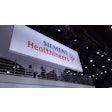
In early July, Tyco International of Pembroke, Bermuda completed its plan to spin off into three separate entities: Tyco International, Tyco Electronics, and Covidien. The last of the three, Covidien, was formed to include Tyco's activities in healthcare, and shares of the newly created company began trading on July 2.
With headquarters in Mansfield, MA, Covidien has global revenues of $9.6 billion and employs 43,000 people. The company's activities run the gamut from medical imaging to surgical devices, pharmaceutical products, and medical supplies, and include brands as varied as Mallinckrodt, Kendall, Autosuture, U.S. Surgical, Nellcor, and Puritan Bennett.
AuntMinnie.com recently spoke with Covidien executive Rick Lytle, U.S. vice president and general manager of Covidien Imaging Solutions, on the makeup of the new company and its directions for future growth.
Can you describe some of the reasons for the Tyco spinoff?
Tyco International was a major conglomerate that came together for the most part during the '90s. We feel very good about the benefits of being more focused on healthcare products and less focused on being part of a larger conglomerate.
 |
| Rick Lytle, U.S. vice president and general manager, Covidien Imaging Solutions. |
People in radiology are pretty familiar with some of the components of Covidien, like Mallinckrodt. What are some other components of the company that people might not be so familiar with?
What was previously Tyco Healthcare was a group of many well known market-leading brands. You may be familiar with Kendall, U.S. Surgical, Valleylab, Nellcor, and Puritan Bennett. Those are the key companies that were formerly Tyco Healthcare, and we're all going to unite under the Covidien brand.
What are the revenues of the imaging business?
Last year globally we did just over $850 million, and that is part of what is over a $10 billion Covidien healthcare unit. So we are roughly 10% of the total Tyco Healthcare business.
To what extent are you getting back to your roots, before Tyco bought Mallinckrodt in 2000?
As an organization, we will continue to capitalize on what grew the business, which is innovation. We are going to do it through a few different ways, we are going to focus more heavily on R&D. Mallinckrodt in its lifecycle has had different times in its more than 100-year history where it spent more on R&D at certain times and less at others. We have already tripled our R&D dollars specifically dedicated to the imaging solutions business over the last three years, and we will continue to invest more heavily in R&D.
The other way we will innovate is through licensing agreements. We have already started and anticipate more partnerships with technology providers in the imaging space, and to do business development and licensing deals will be another way that we will leverage our existing size to grow even faster.
What were some of the reasons that Tyco gave for implementing this three-way split?
Each of the three companies separately believed they could bring more shareholder value by focusing more acutely on those businesses they compete in. At Covidien, we think we can now compete more effectively for top talent in the healthcare business, and we also know that without gaining large company approval for strategic partnerships we think we can move more rapidly to do more strategic partnerships in the marketplace when we see a new technology come along that fits our portfolio.
We are able to not only increase our R&D spend over the last few years, but we've started even recently with certain licensing agreements like the one we've done with IRadimed (a Winter Park, FL, maker of MRI-compatible infusion pumps that signed a distribution deal with Mallinckrodt in 2006).
So we see any ability going forward to be able to compete for those types of licensing deals more effectively than we have in the past.
Has it been a pretty clean split from Tyco? Are the different businesses concentrated in their own headquarters locations?
We are really organized under four major product platforms. Retail, supplies, devices, and imaging pharmaceuticals. The business has now been organized under those four platforms, and so the operational leadership of those four businesses will make separate decisions around how those organizations will look going forward.
We see here in the imaging and pharma business that there at least short term will be very little operational change to the business. We have always been focused on operational efficiencies; that will not change. We will continue to be very operationally efficient, but going forward we will invest even more than we have in the past in growth areas.
Do you think it is beneficial to be able to move out from under the Tyco brand? It's been a rough few years for that company.
Well, we've made a conscious decision to not only start a new name with Covidien, but to really use that name to charter a new course for the organization. If you break it up, "co" symbolizes together, "vid" means life, and that will be an acute focus of the organization, which will work together with healthcare professionals to create products and solutions to help save lives. That rebranding of the organization was definitely a conscious decision.
Are you going to retain the Mallinckrodt brand?
Although the branding architecture at this point is not final, we do and will fully support in many ways the Covidien branding through various imaging-specific publications, as well as through other marketing means. So you'll see imaging solutions as well as the other businesses rallying behind the Covidien brand, but we also anticipate that the Mallinckrodt brand will be retained for some period for some products. Again, that branding architecture has not yet been completely finalized.
The company had been exhibiting at RSNA and other trade shows as "Mallinckrodt, a Tyco Healthcare company." Will you now exhibit as "Mallinckrodt, a Covidien company," or will it just be Covidien?
Right now we are all united behind the Covidien brand. The business units and the various companies I mentioned earlier are all out there now really behind this Covidien brand. You'll see a lot branded as Covidien Imaging Solutions.
It sounds like the Covidien brand is going to get more play than Mallinckrodt did.
It will clearly get more play. There has not yet been a final decision on whether or not it will completely replace the Mallinckrodt brand.
What sort of plans do you have for making the imaging community more aware of the new branding?
Our corporate office in Mansfield, which is the Covidien headquarters, has done quite a bit with the national marketing opportunities. For example, the Covidien brand is very prominent right now on the Green Monster at Fenway Park (in Boston), so there is that layer of branding that has already taken place.
We are working currently with our corporate headquarters in Mansfield on how to promote the Covidien brand in specific imaging trade publications to better target our target audience of radiologists, hospital administrators, and radiologic technologists.
Can you give us a quick breakdown of the company's businesses in imaging? We talked earlier about imaging being about 10% of Covidien. What are some of the major areas within the imaging segment of your company?
We really look at our business broken down into three major product categories: contrast media, delivery systems, and nuclear medicine. Going forward we intend to continue to support and grow those three franchises.
In contrast media, the focus is on strengthening our Optiray and OptiMark brands, the contrast delivery systems, being the OptiVantage brand, which is well known, to support our injectors, and the Liebel-Flarsheim brand, which is part of injectors.
Mallinckrodt years ago bought Liebel-Flarsheim, so you'll still see that there is some Liebel-Flarsheim branding out there, although we have moved most of that over to Mallinckrodt, and right now we are heavily promoting our OptiVantage injector, which is our latest generation injector for CT, and Optistar, which is our latest generation brand for our MR injectors.
On the nuclear medicine side we have nuclear medicine pharmacies as well as the manufacturing of nuclear medicine products.
Who is the CEO of Covidien?
Richard Meelia, he is the president and CEO. He's been our leader for a number of years, he headed up Tyco Healthcare under Tyco International. He was a big part of the growth of the business from when it started after Kendall, which was Tyco International's first acquisition in the healthcare business, and Rich was the president of Kendall at that time, and has since stayed on as the head of healthcare through the significant growth to what is now a $10 billion company.
Who is the leader of the imaging business?
Timothy Wright is the sector president responsible for the global imaging solutions business and the pharmaceutical business, both of which are headquartered in Hazelwood, MO.
Steve Hanley is the global business unit president for imaging solutions. Tim has a global business unit leader for imaging solutions, which is Steve Hanley, and for the pharmaceutical business, that global business unit president position is current open.
Regarding your R&D activities, is there anything in the pipeline that you can share with us that's intriguing?
We have more than tripled our R&D dollars in the last three years. That's across all imaging modalities, including nuclear medicine, contrast (which includes CT and MR), and contrast devices. I can't speak in any more detail as to how we're allocating those dollars, but we are investing in all four of those areas.
Any areas in your business that you see as presenting particularly interesting opportunities?
The good thing about the business that we're in is that all of these modalities are growing in mid-single digits in some cases, high single digits and low double digits in others. Just to be able to maintain our share in contrast media delivery systems and nuclear medicine means that we are in growing businesses.
One area that we've recently made a strategic licensing move is in MR, to help leverage our OptiMark MRI agent business. We did an agreement with a company called IRadimed, and they have what's called an MRidium pump that's used exclusively in the MR suite. There is a good example of how we saw technology that fit in the space that we compete in, and moved quickly to do a deal, and we're coming up on a year there (with that relationship).
Do you see the company keeping an eye out for potential acquisitions, or do you see most of your growth coming organically from internal product development?
We are acutely focused on internal product development. The R&D investment takes anywhere from 2-10 years to bear fruit, so as we increase R&D investment we will also look outside for business development and licensing deals, like MRidium. If we see acquisitions that fit into our current product portfolio we could pursue acquisitions as well.
Any particular challenges you see out there in the imaging area? We all know that reimbursement has been a pretty sensitive area due to the Deficit Reduction Act (DRA) of 2005.
(Radiology) is a good business to be in because there are more and more diagnoses of diseases that can be done through imaging modalities versus invasive procedures. So although the economics related to reimbursement will continue to be a challenge for our customers, we know that ultimately there are typically cost savings associated with imaging diagnosis versus more invasive procedures.
What else can the imaging community expect from Covidien that might be a little different than what they might be used to under Tyco Healthcare?
As evidenced by our name, Covidien, we expect to put a lot of energy towards working with the healthcare community and healthcare providers to not only create value-added programs and services to support our current line, but as we launch new products we intend to have very close partnerships with the healthcare community to ensure there is a need for such products prior to launch. That is a key benefit in cultural change you'll see associated with Covidien, specifically in the imaging solutions business.
The other thing that our restructuring will yield is faster growth outside the U.S. The global business unit president, Steve Hanley, is responsible for global imaging sales. That is a focus, to take our very strong well-established brands of products that are here in the U.S. and utilize that global distribution footprint to grow our business outside the U.S. as well.
What percentage of your sales come from the U.S., and what percentage are international?
We did last year globally we did over $850 million. Roughly 70% to 80% of that was in the U.S., leaving 20% to 30% outside the U.S. Going forward, we see growth outside the U.S. as more likely in terms of percentage than in the U.S.
Any particular products you see as promising for international growth?
There is an acute focus in Europe, as well as developing countries. We know that the Optiray brand is strong in the U.S. and is gaining more prominence outside the U.S. Optiray as our key contrast media franchise we see growing outside the U.S., predominantly in Europe and developing countries.
We are also seeing growth in our delivery systems as well, injectors are growing outside the U.S., and our nuclear medicine business is growing at double digits outside the U.S. as well. So it's really across all our businesses, where we know we can leverage this global footprint to grow our business outside the U.S.
Another big issue that has been affecting all the major contrast companies has been the gadolinium issue, with links to nephrogenic system fibrosis (NSF) in patients who have received gadolinium. How is Covidien handling that?
First and foremost, we want to put patient safety at the forefront of our minds. To take a disease like nephrogenic systemic fibrosis and its seriousness, and given the possible link to gadolinium agents, we are cooperating fully with the FDA as they have taken the lead in trying to determine the link between NSF and gadolinium agents.
By Brian CaseyAuntMinnie.com staff writer
August 20, 2007
Related Reading
Covidien makes debut as Tyco spinoff, July 5, 2007
E-Z-EM to fight Tyco lawsuit, July 2, 2007
Tyco Healthcare names Wright as pharma/imaging president, March 20, 2007
Tyco hit with lawsuit over gadolinium reaction, March 19, 2007
Tyco to spin off healthcare division, January 25, 2007
Copyright © 2007 AuntMinnie.com



















